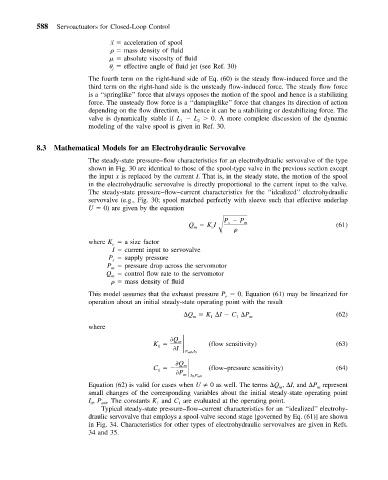Page 597 - Mechanical Engineers' Handbook (Volume 2)
P. 597
588 Servoactuators for Closed-Loop Control
¨ x acceleration of spool
mass density of fluid
absolute viscosity of fluid
effective angle of fluid jet (see Ref. 30)
j
The fourth term on the right-hand side of Eq. (60) is the steady flow-induced force and the
third term on the right-hand side is the unsteady flow-induced force. The steady flow force
is a ‘‘springlike’’ force that always opposes the motion of the spool and hence is a stabilizing
force. The unsteady flow force is a ‘‘dampinglike’’ force that changes its direction of action
depending on the flow direction, and hence it can be a stabilizing or destabilizing force. The
valve is dynamically stable if L L 0. A more complete discussion of the dynamic
2
1
modeling of the valve spool is given in Ref. 30.
8.3 Mathematical Models for an Electrohydraulic Servovalve
The steady-state pressure–flow characteristics for an electrohydraulic servovalve of the type
shown in Fig. 30 are identical to those of the spool-type valve in the previous section except
the input x is replaced by the current I. That is, in the steady state, the motion of the spool
in the electrohydraulic servovalve is directly proportional to the current input to the valve.
The steady-state pressure–flow–current characteristics for the ‘‘idealized’’ electrohydraulic
servovalve (e.g., Fig. 30; spool matched perfectly with sleeve such that effective underlap
U 0) are given by the equation
P P m
s
Q KI (61)
m
v
where K a size factor
v
I current input to servovalve
P supply pressure
s
P pressure drop across the servomotor
m
Q control flow rate to the servomotor
m
mass density of fluid
0. Equation (61) may be linearized for
This model assumes that the exhaust pressure P e
operation about an initial steady-state operating point with the result
Q K I C P m (62)
1
m
1
where
K
Q
m
1
I (flow sensitivity) (63)
,I
P m00
C
Q
m
1 (flow–pressure sensitivity) (64)
P
0
m I ,P m0
Equation (62) is valid for cases when U 0 as well. The terms Q , I, and P represent
m
m
small changes of the corresponding variables about the initial steady-state operating point
I , P . The constants K and C are evaluated at the operating point.
0
m0
1
1
Typical steady-state pressure–flow–current characteristics for an ‘‘idealized’’ electrohy-
draulic servovalve that employs a spool-valve second stage [governed by Eq. (61)] are shown
in Fig. 34. Characteristics for other types of electrohydraulic servovalves are given in Refs.
34 and 35.

